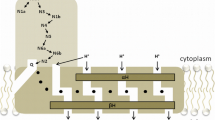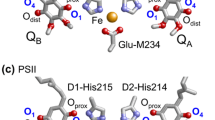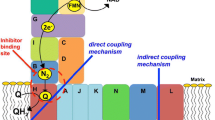Summary
Several enzyme systems have been proposed to play a role in the maintenance of ubiquinol in membranes other than the inner mitochondrial membrane. The aim of this study was to investigate the mechanisms involved in NADH-driven regeneration of antioxidant ubiquinol at the plasma membrane. Regeneration was measured by quantifying the oxidized and reduced forms of ubiquinone by electrochemical detection after separation by high-performance liquid chromatography. Plasma membrane incubation with NADH resulted in the consumption of endogenous ubiquinone, and a parallel increase in ubiquinol levels. The activity showed saturation kinetics with respect to the pyridine nucleotides and was moderately inhibited byp-hydroxymercuribenzoate. Only a slight inhibition was achieved with dicumarol at concentrations reported to fully inhibit DT-diaphorase. Salt-extracted membranes displayed full activity of endogenous ubiquinol regeneration, supporting the participation of an integral membrane protein. In liposomes-reconstituted systems, the purified cytochromeb 5 reductase catalyzed the reduction of the natural ubiquinone homologue coenzyme Q10 at rates accounting for the activities observed in whole plasma membranes, and decreased the levels of lipid peroxidation. Our data demonstrate the role of the cytochromeb 5 reductase in the regeneration of endogenous ubiquinol.
Similar content being viewed by others
Abbreviations
- AAPH:
-
2,2′-azobis-(2-amidinopropane) hydrochloride
- CoQ:
-
coenzyme Q, ubiquinone
- CoQH2 :
-
reduced coenzyme Q, ubiquinol
- pHMB:
-
p-hydroxymercuribenzoate
References
Alcaín FJ, Burón MI, Rodríguez-Aguilera JC, Villalba JM, Navas P (1990) Ascorbate free radical stimulates the growth of a human promyelocytic leukemia cell line. Cancer Res 50: 5887–5891
— —, Villalba JM, Navas P (1991) Ascorbate is regenerated by HL-60 cells through the transplasmalemma redox system. Biochim Biophys Acta 1073: 380–385
—, Villalba JM, Löw H, Crane FL, Navas P (1992) Ceruloplasmin stimulates NADH oxidation of pig liver plasma membrane. Biochem Biophys Res Commun 186: 951–955
Babior BM (1997) Superoxide: a two-edged sword. Braz J Med Biol Res 30: 141–155
Beyer RE (1994) The role of ascorbate in antioxidant protection of biomembranes: interaction with vitamin E and coenzyme Q. J Bioenerg Biomembr 26: 349–358
Beyer RE, Segura-Aguilar J, Di Bemardo S, Cavazzoni M, Fato R, Fiorentini D, Galli MC, Setti M, Landi L, Lenaz G (1996) The role of DT-diaphorase in the maintenance of the reduced antioxidant form of coenzyme Q in membrane systems. Proc Natl Acad Sci USA 93: 2528–2532
Buettner GR (1993) The pecking order of free radicals and antioxidants: lipid peroxidation, α-tocopherol, and ascorbate. Arch Biochem Biophys 2: 535–543
Cairo G, Castrusini E, Minotti G, Bernelli-Zazzera A (1996) Superoxide and hydrogen peroxide-dependent inhibition of iron regulatory protein activity: a protective stratagem against oxidative injury. FASEB J 10: 1326–1335
Constantinescu A, Han D, Packer L (1993) Vitamin E recycling in human erythrocyte membranes. J Biol Chem 268: 10906–10913
—, Maguire JJ, Packer L (1994) Interactions between ubiquinones and vitamins in membranes and cells. Mol Aspects Med 15: S57-S65
Ernster L, Dallner G (1995) Biochemical, physiological and medical aspects of ubiquinone function. Biochim Biophys Acta 1271: 195–204
Favreau LV, Pickett CB (1991) Transcriptional regulation of the rat NAD(P)H:quinone reductase gene: identification of regulatory elements controlling basal level expression and inducible expression by planar aromatic compounds and phenolic antioxidants. J Biol Chem 266: 4556–4561
Goldman R, Tsyrlov IB, Grogan J, Kagan V (1997) Reactions of phenoxyl radicals with NADPH-cytochrome P-450 oxidoreductase and NADPH: reduction of the radicals and inhibition of the enzyme. Biochemistry 36: 3186–3192
Gómez-Diáz C, Rodríguez-Aguilera JC, Barroso MP, Villalba JM, Navarro F, Crane FL, Navas P (1997) Antioxidant ascorbate is stabilized by NADH-coenzyme Q10 reductase in the plasma membrane. J Bioenerg Biomembr 29: 251–257
Kagan VE, Serbinova EA, Safadi A, Catudioc JD, Packer L (1992) NADPH-dependent inhibition of lipid peroxidation in rat liver microsomes. Biochem Biophys Res Commun 186: 74–80
—, Nohl H, Quinn PJ (1996) Coenzyme Q: its role in scavenging and generation of radicals in membranes. In: Cadenas E, Packer L (eds) Handbook of antioxidants. Marcel Dekker, New York, pp 157–201
—, Arroyo A, Tyurin VA, Tyurina YY, Villalba JM, Navas P (1998) Plasma membrane NADH-coenzyme Q0 reductase generates semiquinone radicals and recycles vitamin E homologue in a superoxide-dependent reaction. FEBS Lett 428: 43–46
Kirn C, Crane FL, Becker GW, Morré DJ (1995) Purification of NADH cytochromeb 5 reductase from rat liver plasma membranes. Protoplasma 184: 111–117
Kuypers FA, van den Berg JJM, Schalkwijk C, Roelofsen B, Op den Kamp JAF (1987) Parinaric acid as a sensitive fluorescent probe for the determination of lipid peroxidation. Biochim Biophys Acta 921: 266–274
Lagendijk J, Ubbink JB, Vermaak WJH (1996) Measurement of the ratio between the reduced and oxidized forms of coenzyme q10 in human plasma as a possible marker of oxidative stress. J Lipid Res 37: 67–75
Landi L, Fiorentini D, Galli MC, Segura-Aguilar J, Beyer RE (1997) DT-diaphorase maintains the reduced-state of ubiquinones in lipid vesicles thereby promoting their antioxidant function. Free Radie Biol Med 22: 329–335
Machlin LJ, Bendich A (1987) Free radical tissue damage: protective role of antioxidant nutrients. FASEB J 1: 441–445
Nakamura M, Hayashi T (1994) One- and two-electron reduction of quinones by rat liver subcellular fractions. J Biochem 115: 1141–1147
Navarro F, Villalba JM, Crane FL, Mackellar WC, Navas P (1995) A phospholipid-dependent NADH-coenzyme Q reductase from liver plasma membrane. Biochem Biophys Res Commun 212: 138–143
- Navas P, Burgess JR, Bello RI, de Cabo R, Arroyo A, Villalba JM (1998) Vitamin E and selenium deficiency induces the expression of the ubiquinone-dependent antioxidant system at the plasma membrane. FASEB J 12 (in press)
Navas P, Buron MI (1990) Roles of pyridine nucleotides in the control of cell growth. In: Crane FL, Morré DJ, Löw HE (eds) Oxidoreduction at the plasma membrane: relation to growth and transport, vol 1, animals. CRC Press, Boca Raton, pp 225–236
Santos-Oca∼na C, Córdoba F, Crane FL, Clarke CF, Navas P (1998) Coenzyme Q6 and iron reduction are responsible for the extracellular ascorbate stabilization at the plasma membrane ofSaccharomyces cerevisiae. J Biol Chem 273: 8099–8105
Schultz JR, Ellerby LM, Gralla EB, Valentine JS, Clarke CF (1996) Autoxidation of ubiquinol-6 is independent of superoxide dismutase. Biochemistry 35: 6595–6603
Stoyanovsky DA, Osipov AN, Quinn PJ, Kagan V (1995) Ubiquinone-dependent recycling of vitamin E radicals by superoxide. Arch Biochem Biophys 323: 343–351
Sun IL, Sun EE, Crane FL, Morré DJ, Lindgren A, Löw H (1992) Requirement for coenzyme Q in plasma membrane electron transport. Proc Natl Acad Sci USA 89: 11126–11130
Takahashi T, Shitashige M, Okamoto T, Kishi T, Goshima K (1993a) A novel ubiquinone reductase activity in rat cytosol. FEBS Lett 314: 331–334
—, Okamoto T, Mori K, Sayo H, Kishi T (1993b) Distribution of ubiquinone and ubiquinol homologues in rat tissues and subcellular fractions. Lipids 28: 803–809
—, Yamaguchi T, Shitashige M, Okamoto T, Kishi T (1995) Reduction of ubiquinone in membrane lipids by rat liver cytosols and its involvement in the cellular defence system against lipid peroxidation. Biochem J 309: 883–890
—, Okamoto T, Kishi T (1996) Characterization of NADPH-dependent ubiquinone reductase activity in rat liver cytosol: effect of various factors on ubiquinone-reducing activity and discrimination from other quinone reductases. J Biochem 119: 256–263
Villalba JM, Navarro F, Córdoba F, Serrano A, Arroyo A, Crane FL, Navas P (1995) Coenzyme Q reductase from liver plasma membrane: purification and role in trans-plasma-membrane electron transport. Proc Natl Acad Sci USA 92: 4887–4891
Williams CH (1976) Flavin-containing dehydrogenases. In: Boyer PD (ed) The enzymes, vol 13. Academic Press, New York, pp 89–173
Yang MX, Cederbaum AI (1996) Interaction of ferric complexes with NADH-cytochromeb 5 reductase and cytochrome b5: lipid peroxidation, H2O2 generation, and ferric reduction. Arch Biochem Biophys 331: 69–78
Author information
Authors and Affiliations
Rights and permissions
About this article
Cite this article
Arroyo, A., Navarro, F., Navas, P. et al. Ubiquinol regeneration by plasma membrane ubiquinone reductase. Protoplasma 205, 107–113 (1998). https://doi.org/10.1007/BF01279300
Received:
Accepted:
Issue Date:
DOI: https://doi.org/10.1007/BF01279300




